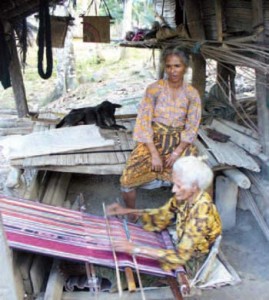Outer garments
a three-quarter length good quality and water proof parka with hood and draw cord. Also a draw cord at the waist, with full-length zip (Gore-Tex is ideal but expensive)
nylon waterproof outer pants are very useful in the wet grassy areas as they reduce heat loss, prevent leg cuts and scratches, stop leeches and keep your bum dry when sitting on the wet ground. Pajama style with elastic waist is ideal.
tropical long sleeved shirt with a collar, pockets and full front opening. the long sleeves reduce the chances of evening mosquito bites.
fiber pile type jacket with full heavy-duty zip. They are light and retain heat even when wet.

Other clothes
long trousers to be used in combination with over pants in wet high mountains and in coastal areas in the evening to guard against mosquito bites. Shorts are OK for walking in the warmer areas.
underwear: cotton to use in warmer areas. Thermal T shirt in cold, wet areas as this material wicks perspiration away from the body and dries quickly.
headgear: a wide brimmed hat for sun protection and a quality beanie or balaclava to reduce the huge heat loss from the head, when cold.
boots & socks: thick, resilient socks such as Explorer. Medium weight boots. Most important is a sharp, aggressive tread, necessary for the very steep descents.
|
Equipment, water & food
Medium rated sleeping bag suitable for zero or 1 to 2 degrees Celsius to be carried in waterproof, plastic bag. Full-length zip allows bag to be opened and used as a blanket in warmer areas.

TIAS WEAVERS ILLIOMA
lightweight sleeping mat
Plastic sheet approximately 3 to 4 meters square and rope for shelter if delayed by rain or cloud. Can be used to cook under or as shelter for your guide if insufficient room in the tent. Also extra rope.
light weight two person tent. Inner to be used as a mosquito dome including in urban areas. Needs to have very good ventilation to use in warmer low land areas. Outer to be attached in wet or dewy uplands.
Trangia type methylated spirit stove is ideal as it has pots included. Methylated spirits can only be purchased in the larger Dili supermarkets. An alternative fuel is 90% plus medical alcohol.
All creek water needs boiling for three to four minutes or some other means of purification. Local people will drink from some springs but boil all other water before drinking.
food: Carry two days supply, including food for the guide. Unless conditions are very dry vegetables and fruit can be purchased from markets and farmers during the walk. Noodles and rice are easy to carry and quick to prepare. Some of that food can be carried in a billy or aluminum pot with a handle. (This allows rice to cook on a fire at the same time as other food is prepared on the stove.)
Water container: Take a two liter container however in some dry areas carry an extra bottle.
|